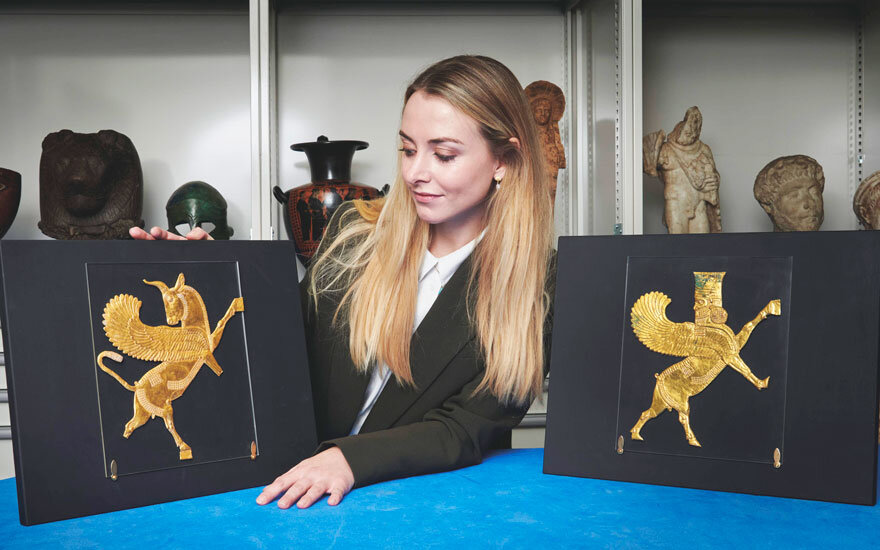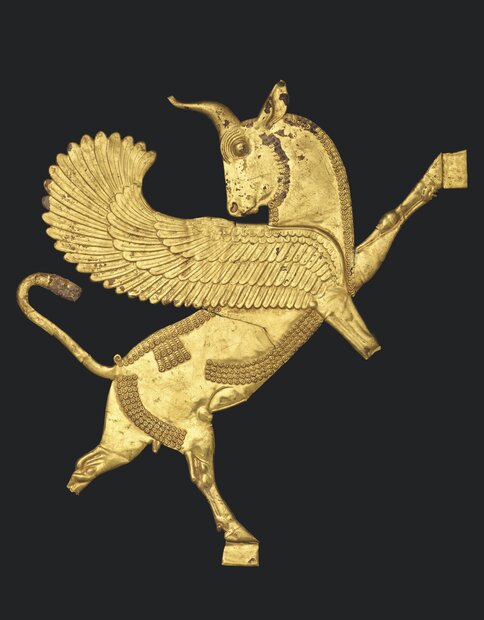Sold! Iranian treasures went under the hammer in London auction

TEHRAN – On December 8, two majestic royal gold plaques among other ancient Iranian treasures went under the hammer for hundreds of thousands of pounds at Christie’s in London.
What makes the auction awkward is a serious doubt over the way the antiquities had found their way overseas. The auction, for some art lovers, equals an illegitimate act of selling the “looted treasure” of a nation.
Some say the two extraordinary Achaemenid objects, which depict a winged bull, and a lamassu were smuggled out of Iran following their excavation in 1920.
ISNA, the students’ news agency, on Saturday, wrote activists monitoring the international sale of antiquities say they had long ago informed the Ministry of Cultural Heritage, Tourism, and Handicrafts about the upcoming sale of these two gold arts at the Christie's.
What the activists demand is firm governmental efforts to file a lawsuit against those who illegally keep Iranian antiquities.
“But no [strong] action was taken to prevent the auction to return those gorgeous artworks home,” the report said.
In contrast, ISNA reminded the fate of an exquisite Achaemenid-era relief that was returned home some 80 years of being in exile changing hands among smugglers. The eight-inch-square piece of carved limestone, which was part of a long line of soldiers depicted on a balustrade at the central building on the Persepolis site, was repatriated under a rule laid down by a U.S. court back in 2018.

An Achaemenid gold appliqué of a winged bull, reign of Artaxerxes II, 404-359 BC. 9⅝ in (24.4 cm) high. Estimate: £100,000-150,000. Offered in Antiquities on 8 December 2021 at Christie’s in London (Credit: Christie’s)
In another successful attempt, the Islamic Republic with the aid of Swiss officials repatriated 49 works of ancient art looted and smuggled out of the country some four decades ago. It was a collection of glazed bricks, dating back to the 7th or 8th centuries BC.
Reverting to the gold appliqués, they were excavated from near the west-central city of Hamadan. Moreover, the site yielded Achaemenid citadel towers, column bases decorated with arabesques, faience tiles, and the sculpted head of a prince during excavations led by the French scholar Charles Fossey.
“Yet the most dazzling discovery by far was a trove of 23 gold items — among them the two plaques coming to auction — that also included statues of goats and camels, items of jewelry, and two tablets with inscriptions dating the hoard to the reign of King Artaxerxes II (404-359 BC),” according to Christie’s.
It is worth mentioning that Artaxerxes II was a powerful monarch who magnificently defended the largest empire the ancient world had ever seen, which stretched from Greece to India. Moreover, Artaxerxes II waged successful campaigns against the Spartans, Athenians, and Egyptians as well. Much of the king’s wealth was lavished on building projects, including the restoration of the palace of his predecessor, Darius I, at Susa, a new hall at Hamadan, and his own tomb at Persepolis.

An Achaemenid gold appliqué of a lamassu, reign of Artaxerxes II, 404-359 BC. 9 in (23.1 cm) high. Estimate: £100,000-150,000. Offered in Antiquities on 8 December 2021 at Christie’s in London. (Credit: Christie’s)
The principal periods of gold production in pre-Islamic Persia occur in the late second and early first millennia BC, during the Achaemenid period, and in the early first millennium CE as the Persian empire possessed a number of gold sources within its borders. There are Greek and Roman sources and historians who described how Achaemenid buildings were covered in spectacular amounts of gold. It is said that Persepolis alone once contained 2,500 tonnes of gold. Furthermore, Herodotus wrote that Achaemenid soldiers ‘glittered all over with gold, vast quantities of which they wore about their person’.
Mythical creatures such as sphinx and griffin had a special position in the culture of people in the Achaemenid empire, for instance, winged bulls and lamassus represented strength and protection. Apart from tiny models, their monumental versions were often carved in high relief to stand guard over entrance portals, including the famous Gate of All Nations in Persepolis.
Over the past decades, those gold models of mythical beasts have gained for their delicacy and beauty of construction.
For instance, American art historian Arthur Upham Pope reviewed them in 1948 when they went on display at the Musée Cernuschi in Paris. Pope wrote, “the art and culture of Achaemenids reached one of the high peaks in human experience”.
In conclusion, there is a fundamental question that remains unanswered. We know many museums and private collectors around the world keep art and artifacts that were stolen from their countries of origin during turbulent times. Do they have the right to keep, show and trade those objects or not?
AFM
Leave a Comment